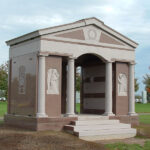Metairie Cemetery Mausoleums, New Orleans, Louisiana

Metairie Cemetery is home to the largest collection of marble tombs and funeral statuary in historic New Orleans. The cemetery is located within the New Orleans city limits, next to the area that was formerly Bayou Metairie. Metairie Cemetery was entered into the National Register of Historic Places in 1991, and is the burial place of many famous people from the region.
History of Metairie Cemetery
The site of the Metairie Cemetery was formerly a horse racing track, the Metairie Race Course. Local resident Charles T. Howard was denied membership by the Metairie Jockey Club, and he vowed that the race course would someday become a cemetery. True to Howard’s curse, the track went bankrupt after the Civil War and Reconstruction, and the land where it once stood became Metairie Cemetery. The cemetery was built in 1872, and Howard was buried in a tomb on Central Avenue in the cemetery, which follows the original oval layout of the track.
In 1969, Metairie Cemetery was purchased by Stewart Enterprises, that owned neighboring Lake Lawn Park Cemetery, and today it’s known as Lake Lawn Metairie Funeral Home and Cemeteries.
Burial in Metairie Cemetery
Lake Lawn Metairie Cemetery offers several options for in-ground burial. Families and individuals can choose from beautifully manicured gardens and special areas to find the perfect resting place. In-ground burial options include:
- Upright memorials
- Lawn crypts
- Elevated lawn crypt gardens
- Private family estate area
Cremation and Metairie Cemetery
Metairie Cemetery offers several ways to accommodate cremation, including a choice in options to memorialize, shelter, and protect the remains:
- Cremation gardens
- Private family mausoleums
- Niche estate areas
- Columbaria
- Glass-front niches
- Ground burial
- Cremation benches and pedestals
Metairie Cemetery Private and Family Mausoleums
While Metairie Cemetery is quite accommodating for in-ground burial and cremation, this historical cemetery is perhaps best known for its impressive private mausoleums and family mausoleums. These structures, built to memorialize individuals or families, endure the test of time and leave a lasting testament to the individuals, as well as to architectural and artistic tastes at the time. A few of the most noteworthy private and family mausoleums at Metairie Cemetery include:
- Egan Tomb: One of the oldest tombs in the Metairie Cemetery, the Egan Tomb is also one of the most unique and creative replica tombs in the world. This tomb’s design is taken from a small chapel on the family’s estate in Ireland – a chapel that had been burned and vandalized, and lay in ruins. This Pierre Casse design involved carving the marble to make it appear chipped, cracked and broken.
- Pizzati Mausoleum: The Pizzati mausoleum, manufactured by Charles Orleans from a design by architect Charles Brune, is one of the most eclectic mausoleums in Metairie Cemetery. This private mausoleum is an ornate collection of Medeival turrets, curved dentils, Byzantine Columns, a blind window, an alpha and omega symbol and a draped urn. This whimsical and eccentric mausoleum appears to be the result of competition among mausoleum builders to build the best, and try to create a truly unique offering.
- Larenden Tomb: The Larenden Tomb, a unique family mausoleum commissioned for Laure Beauregard, her husband, and her two children, features a Moorish design built with dark Belgian limestone. The lobed horseshoe arches and dome crowned with the Eastern Orthodox cross create a somber mood, which is enlivened somewhat by the circular stained glass window set into the arch above the tomb.
Metairie Cemetery is home to many unique private and family mausoleums. As a national historic site and a living testament to New Orleans’ eclectic history, this cemetery is a fitting site for the final resting place of a loved one.
